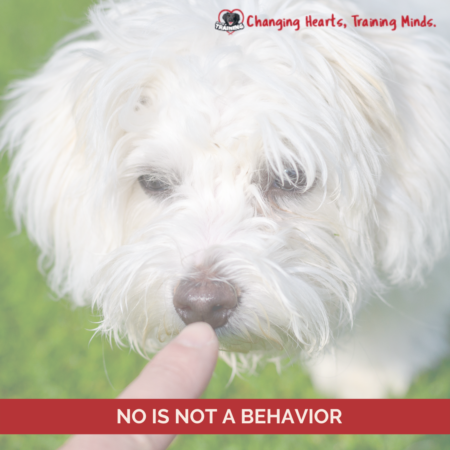Humans seem to love the word NO when it comes to interacting with their dogs. And they’re surprised and a little confused when I tell clients “No isn’t a behavior.” “But I want him to stop doing {fill in the blank} so I tell him no.” Here’s a newsflash – dogs don’t speak our language. They don’t know what no means on its own. As humans when we say no and we’re trying to use it in a context where we’re trying to stop behavior, I’d bet big money that it’s being said in a gruff tone, raised voice or other somewhat startling or intimidating way. And if it “works” by stopping the behavior, chances are you’ve just frightened your dog but he didn’t learn anything in that moment, other than sometimes you’re a little scary.
When we scold or say no during housetraining accidents, this can cause reverse housetraining, where the dog becomes afraid to potty in front of humans and reverse housetraining can be very difficult to reverse.
So say it with me. NO IS NOT A BEHAVIOR.
I recently covered the topic of making sure we’re meeting our dog’s needs, especially if we notice a trend of unwanted behavior like digging, chewing, tugging or chasing. It’s key to ensure we’re giving dogs healthy outlets for normal dog behaviors. But, what if we’re doing that and we still have an issue? How do we stop or “correct” unwanted behaviors? Easy! We need to teach the dog an alternative behavior that is incompatible with the one we don’t like and reward it heavily so that behavior we do want, pays off for the dog more than the one we don’t want. Don’t like the dog jumping on people? Teach him to sit to be patted. Don’t like your dog barking at things on walks? Teach her a leave it or a watch me. Don’t like your dog door dashing? Teach him a wait at open doorways. Don’t like your dog chasing critters? Train a solid recall with a jackpot payoff every single time.
And, as I’ve covered in the past, we never want to scold or punish a dog who is giving us clear communication like growling, lunging or barking. This can suppress that outward communication but behavior suppression isn’t the same as behavior modification. I’ve also written about what to do if your dog growls.
Sometimes management can be your solution here too without any need for training. Don’t like your dog chewing on chair legs? Don’t use temporary aversive quick fixes like Bitter Apple (are you planning on spraying your entire house?). First, tighten up management so he doesn’t have access to those things and then provide him other hard items like antlers, bones or bully sticks.
Remember, we never need to hurt or scare a dog in the name of training. Recently AVSAB, American Veterinary Society of Animal Behavior, the vets who specialize in behavior, recently updated their position statements and released their Humane Dog Training Position Statement. This position statement states:
“Evidence supports the use of reward based methods for all canine training. AVSAB promotes interactions with animals based on compassion, respect, and scientific evidence. Based on these factors, reward-based learning offers the most advantages and least harm to the learner’s welfare. Research supports the efficacy of reward-based training to address unwanted and challenging behaviors. There is no evidence that aversive training is necessary for dog training or behavior modification.”
“Reward-based techniques should be used for teaching common training skills as well as to address unwanted behaviors. The application of aversive methods – which, by definition, rely on application of force, pain, or emotional or physical discomfort – should not be used in canine training or for the treatment of behavioral disorders.”
So say it again with me: NO IS NOT A BEHAVIOR! If you need help with any behavior issue, you can schedule your session here!
Happy training!
![]()




